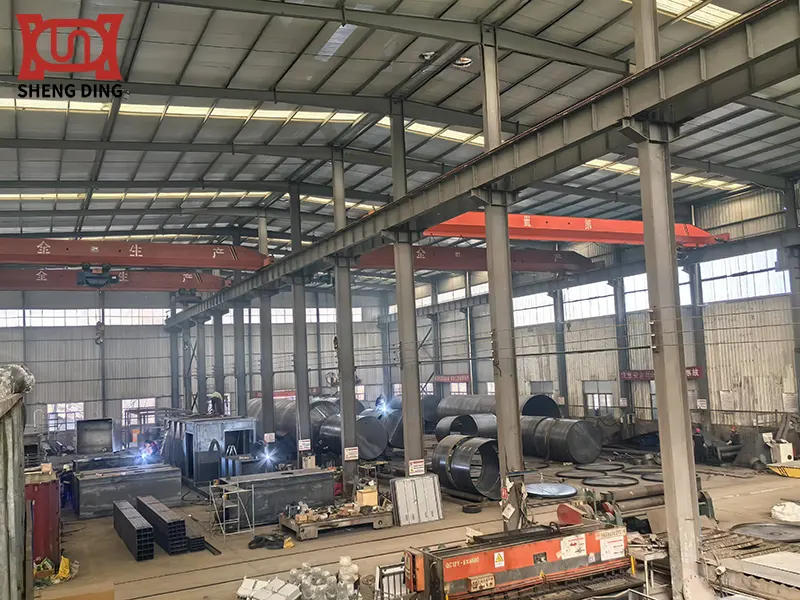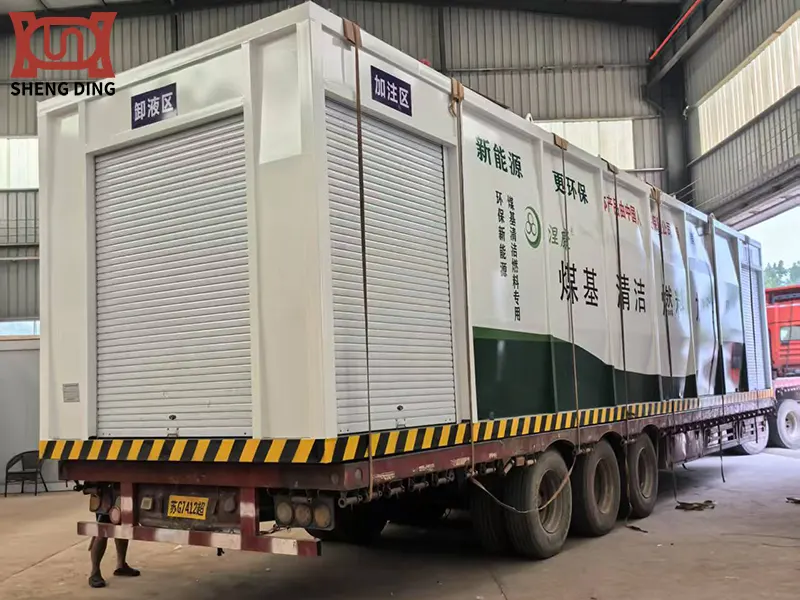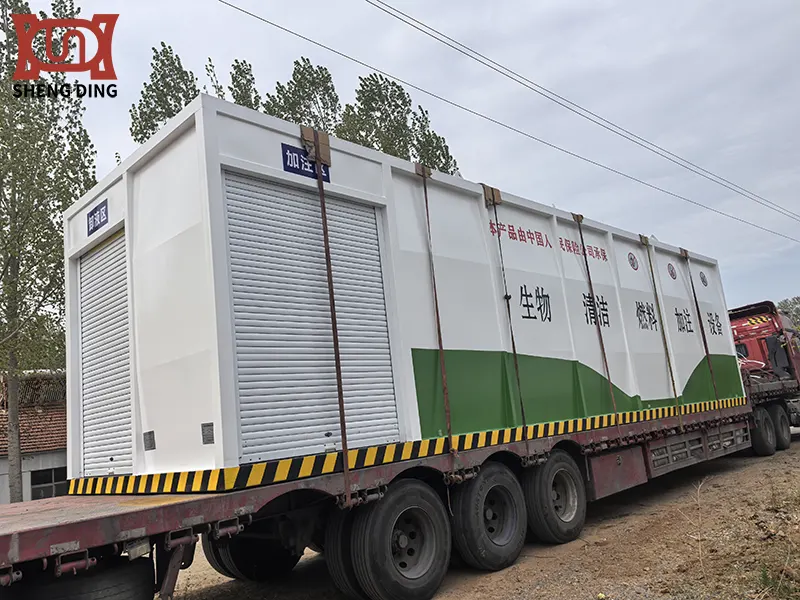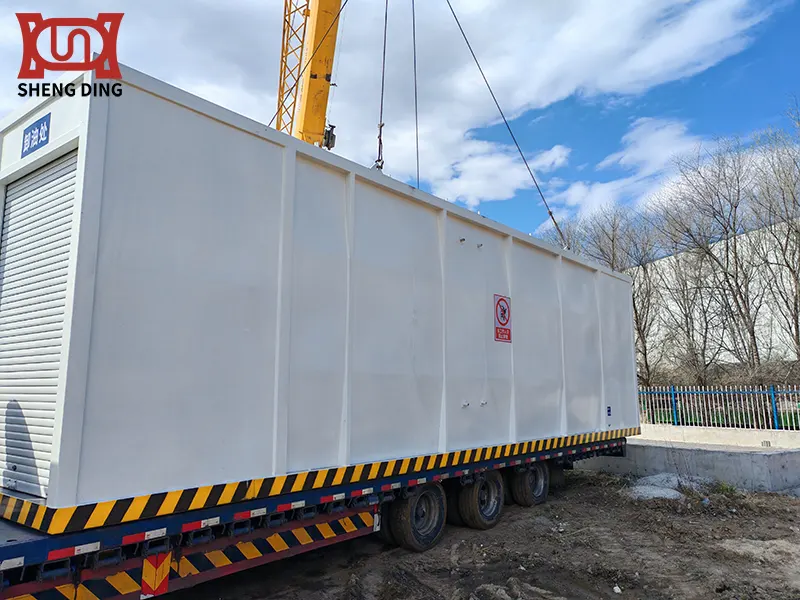Common methods and relevant standards for weld inspection of skid-mounted fuel station
In the production process of skid-mounted gas stations, welding process undoubtedly accounts for the largest proportion of the entire process, and it also has the highest quality requirements. This is mainly because the storage medium of skid-mounted fuel station has high safety requirements. Any small welding defect may lead to major safety accidents, so in the overall product acceptance, weld detection is the most important link. Today we will explain to you the common methods and relevant standards for skid-mounted fuel station weld detection.
The detection of skid-mounted fuel station welding process is very important, because the welding quality is directly related to the structural strength, sealing and safety of the equipment, especially in the pressure vessels and pipeline systems that store flammable and explosive oil products. The detection methods are mainly divided into two categories: destructive testing and non-destructive testing. In practical applications, non-destructive testing is the main means.


Common detection methods for skid-mounted fuel station welding process:
I. Non-destructive testing
This is a test conducted without damaging the object being inspected, and it is the core means of welding quality control.
1. Appearance inspection:
- Method: Use tools such as naked eyes, magnifying glasses, and weld inspection rulers for inspection.
- Purpose: Check whether there are obvious defects on the weld surface, such as:
- Cracks (surface cracks): the most dangerous defects in the welding process.
- Undercut: Undercut refers to the depression or groove formed on the parent material along the weld toe. It is a gap left by the arc melting the parent material at the edge of the weld without sufficient replenishment of the deposited metal.
- Weld nodule: The liquid metal in the weld flows to the insufficiently heated and unmelted parent material or overflows from the root of the weld. The metal nodule that is not fused with the parent material after cooling is called weld nodule.
- Arc pit: The low-lying part formed at the end of the weld due to improper arc closing and arc breaking.
- Surface pores: Porosity refers to the cavity formed by the gas in the molten pool not escaping before the metal solidifies during welding and remaining in the weld.
- Incomplete weld (insufficient excess height): Incomplete weld refers to continuous or intermittent grooves on the surface of the weld. Insufficient filler metal is the root cause of incomplete weld.
- Whether the weld size (width, excess height) meets the requirements
- The leg height and throat thickness of the fillet weld
- Requirements: This is the most basic inspection, usually carried out before the subsequent non-destructive testing, and is also a must-do inspection for all welds. Inspectors must have the corresponding qualifications.
2. Penetrant testing:
- Method: Spray or apply the penetrant containing dye or fluorescent substance on the clean and dry weld surface to penetrate into the surface opening defects; after removing the excess penetrant on the surface, apply a developer to adsorb the penetrant in the defect to the surface to form a visible indication.
- Purpose: Detect surface opening defects such as cracks, pores, pinholes, unfused, delamination, etc.
- Applicable: Applicable to surface inspection of non-porous metal materials (such as austenitic stainless steel and aluminum alloy). Commonly used for surface inspection of containers, pipeline butt welds, and fillet welds.
- Advantages: Relatively simple operation, low cost, and strong adaptability to complex shapes.
- Disadvantages: Only surface opening defects can be detected, internal defects cannot be detected; high requirements for surface finish.
3. Magnetic particle testing:
- Method: Apply a magnetic field to the ferromagnetic material to be tested (such as carbon steel, low alloy steel), and spray magnetic particle suspension on the weld surface. If there are surface or near-surface defects (such as cracks, unfused, inclusions), a leakage magnetic field will be formed, attracting magnetic particles to accumulate and form magnetic traces.
- Purpose: Detect surface and near-surface defects.
- Applicable: Mainly used for weld inspection of ferromagnetic materials, such as carbon steel/low alloy steel welds of skid-mounted station tanks and pipelines.
- Advantages: High sensitivity to surface and near-surface defects, intuitive display of defect location and shape.
- Disadvantages: Only applicable to ferromagnetic materials; requires magnetization equipment; requires demagnetization after inspection; insensitive to deeply buried defects.
4. Radiographic testing:
- Method: Use X-rays or gamma rays to penetrate the workpiece. Due to the different absorption of rays by defective parts and intact parts, images are formed on film or digital detectors to determine the nature, size and location of internal defects.
- Purpose: Detect internal volume defects (pores, slag inclusions) and area defects (incomplete penetration, incomplete fusion), as well as cracks (if the direction is appropriate).
- Application: Comprehensive inspection of butt welds (especially circumferential seams and longitudinal seams of pressure vessels and pipelines). There are certain restrictions on the detection thickness (usually X-ray < 100mm, ¦Ã-ray is thicker).
- Advantages: The results are intuitive (with negative film or image records), easy to save and trace, and highly sensitive to volume defects.
- Disadvantages: High cost (equipment, consumables, protection, qualification of film reviewers); radiation safety risks; sometimes the detection rate of thin layer defects perpendicular to the direction of the ray (such as cracks) is not high; the detection effect of incomplete penetration of the double-sided weld root is good, and the incomplete fusion of the single-sided weld root may be missed; the on-site operation is relatively complicated.
5. Ultrasonic testing:
- Method: Use high-frequency sound waves (ultrasonic waves) to propagate in the workpiece, and reflection, refraction or scattering will occur when encountering defects or interfaces. By analyzing the position, amplitude and waveform characteristics of the reflected echo, the existence, location, size and nature of the defect can be determined.
- Purpose: Detect internal defects (cracks, lack of fusion, lack of penetration, pores, slag inclusions, etc.) and surface defects (need to be combined with specific probes), and measure the depth and height of the defect.
- Application: Very wide, especially suitable for thick-walled welds (such as tank shells, head butt welds), T-joints, fillet welds, etc. High sensitivity to detecting surface defects such as cracks and lack of fusion.
- Advantages: Sensitive to highly harmful surface defects; wide detection thickness range; strong on-site applicability and fast speed; no radiation risk; can provide defect depth information.
- Disadvantages: The results are not as intuitive as RT, and require experienced level II or level III personnel to operate and interpret; high requirements for workpiece surface finish and coupling agent; difficult to detect coarse-grained materials (such as austenitic steel welds); small volume defects (such as point slag inclusions, pores) are not as quantitatively accurate as RT; usually no permanent records (unless TOFD or phased array is performed and data is stored).
6. Eddy current testing:
- Method: Use alternating magnetic field to induce eddy current in conductive materials, and detect defects or performance changes on the surface or near the surface of the material by measuring the changes in the eddy current magnetic field.
- Purpose: Mainly used to detect surface and near-surface cracks, and can also be used for thickness measurement, material sorting, etc.
- Application: Relatively less used in skid-mounted station welding inspection, it may be used to detect surface cracks in thin-walled pipe welds or heat exchanger pipes.
- Advantages: Non-contact or point contact, fast speed, easy to automate.
- Disadvantages: Only applicable to conductive materials; limited penetration depth (usually < 5mm); sensitive to defect shape and orientation; susceptible to interference.
II. Destructive testing
Mainly used for welding process assessment, welder skill assessment, material verification or sampling inspection (in rare cases, destructive sampling of product welds, such as cutting test pieces).
1. Mechanical properties test:
- Tensile test: Determine the tensile strength, yield strength and elongation of welded joints.
- Bending test: (face bending, back bending, side bending) to test the plasticity and surface quality of the weld and heat-affected zone.
- Impact test: Determine the toughness (impact work) of the welded joint at low temperature.
- Hardness test: Measure the hardness distribution of the weld, heat-affected zone, and parent material to evaluate the hardening tendency and softening.
2. Metallographic inspection:
- Macroscopic metallography: Observe the macroscopic structure, penetration, fusion, and presence of macroscopic defects (pores, slag inclusions, incomplete penetration, cracks, etc.) of the cross section of the weld by acid etching or mechanical methods.
- Microscopic metallography: Observe the microstructure, grain size, non-metallic inclusions, etc. of the weld metal and heat-affected zone under a microscope to evaluate whether the structure is normal, whether there is overheating, overburning, hardened structure, etc.
3. Chemical analysis:
Analyze the chemical composition of the weld metal to ensure that it meets the standard requirements (especially the content of alloy elements and harmful elements).
4. Corrosion test:
Tests in specific corrosive environments (such as intergranular corrosion tests) are carried out as required to evaluate the corrosion resistance of welds.
Key points of welding inspection for skid-mounted fuel stations
1. Based on standards:
All inspections must be carried out strictly in accordance with relevant national and industry standards. China's main references include:
- GB 50128 "Vertical Cylindrical Steel Welded Storage Tank Construction and Acceptance Specification" (core standard, covering tank welding and inspection requirements)
- NB/T 47013 "Pressure Equipment Nondestructive Testing" (series of standards, detailed provisions of RT, UT, MT, PT methods and technical requirements)
- GB 50236 "Field Equipment, Industrial Pipeline Welding Engineering Construction Specification" (involving pipeline welding and inspection)
- GB 50074 "Petroleum Depot Design Specification" (involving safety requirements)
- SY/T 0402 "Petroleum and Natural Gas Station Process Pipeline Engineering Construction and Acceptance Specification"
- Product design documents and technical specifications
- Welding process assessment report
2. Personnel qualifications:
Nondestructive testing personnel must hold a qualification certificate of the corresponding level (level I, level II, level III) and method issued by the General Administration of Quality Supervision, Inspection and Quarantine or its authorized agency, and must be valid. Welding inspectors should also have the corresponding qualifications.
3. Inspection ratio and qualified level:
According to the importance of the equipment (such as pressure vessel category), weld type (such as A/B/C/D type weld), design pressure, medium characteristics and other factors, the standards (such as GB 50128, NB/T 47013) will clearly stipulate the inspection methods, inspection ratios (100% or local sampling ratios) and acceptance qualification levels (such as RT level II qualified, UT level I qualified, etc.) that should be adopted for different welds.
4. Welding process assessment and welder examination:
Before welding the product, the welding process used must be assessed and qualified, and the welder/operator performing the welding must hold a valid qualification certificate for the corresponding project. This is the prerequisite for ensuring welding quality.
5. Process control:
Control during the welding process (such as preheating temperature, interlayer temperature, welding parameters, welding material management, environmental conditions) is equally important and is the key to preventing defects.
6. Overall test:
- Pressure test: After the tank and piping system are completed, hydraulic test and/or air pressure test must be carried out to verify the overall strength and sealing.
- Leakage test: For pipeline systems that transport flammable and explosive media, more sensitive leakage tests (such as air tightness tests, helium leak detection, etc.) are usually required.
Conclusion
For the welding process inspection of skid-mounted fuel stations, non-destructive testing (NDT) is the core means to ensure product quality and safety. It is usually necessary to combine multiple methods:
- Appearance inspection: 100% welds must be inspected.
- Magnetic particle testing or penetration testing: used to detect surface defects in all inspectable areas (MT is used for ferromagnetic materials, PT is used for non-ferromagnetic materials or complex surfaces).
- Radiographic testing or ultrasonic testing: used to detect internal defects in butt welds. RT is intuitive and recorded, and is often used for thin-walled or welds that require records; UT is sensitive to surface defects, has high efficiency, is suitable for thick walls, and is often used for major pressure-bearing welds. The specific choice depends on factors such as standard requirements, material thickness, weld location, and defect type sensitivity. Sometimes a combination of the two is required (such as RT+UT).
- Destructive testing is mainly used for process evaluation and welder examinations, and is generally not used for direct inspection of product welds (unless special regulations are made for random inspections).
- Strict implementation of standards, qualified personnel, clear testing requirements, process control and final verification are the key to ensuring the welding quality and operation safety of skid-mounted fuel stations. Be sure to refer to the design documents, contract technical specifications and the latest versions of national mandatory standards and industry standards for specific projects.


Relevant standards for weld inspection of skid-mounted fuel stations:
I. Core mandatory standards (safety bottom line)
1. GB 50128-2014 "Construction and Acceptance Specifications for Vertical Cylindrical Steel Welded Storage Tanks"
- Core status: This is the most fundamental basis for welding and inspection of skid-mounted fuel station tanks (core pressure vessels).
- Scope of application: Normal pressure and micro-internal pressure tanks with a design pressure greater than or equal to -0.49kPa and less than 0.1MPa (G).
Key content:
- Weld classification: Clarify the definition of A, B, C, and D welds (butt welds, fillet welds, etc.).
Non-destructive testing requirements:
- Testing methods: Specify the application scenarios of radiographic testing (RT), ultrasonic testing (UT), magnetic particle testing (MT), and penetration testing (PT).
- Testing ratio: Specify 100% testing or local sampling ratio (such as >= 20%) according to weld type, material thickness, design pressure, etc.
- Qualification level: Clarify the acceptance qualification level of different inspection methods (such as RT, UT) for various types of welds (such as RT II qualified, UT I qualified).
- Visual inspection: Mandatory requirement for 100% visual inspection of all welds, and specify the allowable limit of surface defects.
- Pressure test: Specify the requirements for hydraulic test and/or air pressure test (must be done).
- Leakage test: Leakage test (such as air tightness test) should be carried out on tanks containing flammable, explosive or toxic media.
- Welder and process assessment: Welders are required to be certified before they can work, and the welding procedure specification (WPS) must be based on the qualified welding procedure qualification report (PQR).
2. GB 50074-2014 "Petroleum Depot Design Code"
- Scope of application: Overall design and safety requirements of petroleum depots (including skid-mounted fuel stations).
- Related requirements: Although it does not directly stipulate the inspection process, it puts forward fundamental requirements for the safety, fire and explosion prevention, and leakage control of equipment (storage tanks, pipelines), and indirectly constrains the quality of welds to meet relevant construction acceptance standards (such as GB 50128) to ensure safety. Emphasize the importance of pressure testing.
3. TSG 21-2016 "Regulations on Safety Technical Supervision of Stationary Pressure Vessels" (and supporting specifications)
- Scope of application: When the design pressure of the skid-mounted station tank is >= 0.1MPa, it belongs to the category of pressure vessels and must comply with this regulation and its referenced standards.
- Key requirements:
- More stringent manufacturing, inspection, and testing requirements.
- It is mandatory to conduct welding process qualification (PQR) and welder examinations.
- It is clear that the non-destructive testing methods, proportions, and qualified level requirements (usually citing the NB/T 47013 series).
- It is mandatory to prepare and inspect product welding specimens (destructive testing).
- Design document appraisal and supervision inspection (implemented by the special inspection institute).
4. TSG D0001-2009 "Technical Supervision Regulations for Safety of Pressure Pipelines - Industrial Pipelines" (and supporting specifications)
- Scope of application: Process pipelines with a design pressure of >= 0.1MPa in skid-mounted stations (such as oil unloading and refueling pipelines) belong to GC2 grade industrial pipelines.
- Key requirements:
- Requirements for manufacturing, installation, inspection and testing of pipeline components.
- Welding process assessment, welder examination.
- Non-destructive testing requirements (methods, proportions, qualified levels, usually quoted from NB/T 47013).
- Pressure test, leakage test.
- Installation supervision inspection.
II. Core non-destructive testing method standards (implementation basis)
NB/T 47013-2015 "Non-destructive testing of pressure equipment"
This standard replaces the original JB/T 4730 and is a general and authoritative standard for non-destructive testing of pressure equipment (pressure vessels, pressure pipelines). This standard must be implemented for skid-mounted station tanks (when managed as pressure vessels) and pressure pipelines within the station. It is divided into 11 parts:
- NB/T 47013.1: General requirements - personnel qualifications, equipment calibration, process procedures, etc.
- NB/T 47013.2: Radiographic testing (RT) - technical level, transillumination method, image quality meter, film/digital system, acceptance criteria (level I, II, III, IV).
- NB/T 47013.3: Ultrasonic testing (UT) - technical level, probe, test block, scanning method, defect assessment, acceptance criteria (level I, II, III, IV).
- NB/T 47013.4: Magnetic particle testing (MT) - magnetization method, magnetic suspension, sensitivity test piece, acceptance criteria (limit of defect magnetic trace display length).
- NB/T 47013.5: Penetrant Testing (PT) - Penetrant Types, Cleaning, Imaging, Observation Conditions, Acceptance Criteria (Defect Display Length Limit).
III. Welding process and construction standards
1. GB 50236-2011 "Construction Specifications for Field Equipment and Industrial Pipeline Welding Engineering"
- Scope of application: Field equipment and industrial pipeline welding projects in petrochemical, chemical, power and other industries. Applicable to the welding construction and inspection of process pipelines in skid-mounted stations.
- Key content:
- Welding process qualification (PQR) and welding process specification (WPS) requirements.
- Welder examination and management.
- Pre-welding preparation (groove, assembly, cleaning).
- Welding process control (preheating, layer temperature, parameters).
- Weld repair regulations.
- Welding inspection: Clarify the requirements for appearance inspection, non-destructive testing (methods and proportions are based on design documents or SH/T 3503, etc.), hardness testing, etc. Its non-destructive testing requirements usually refer to NB/T 47013.
2. SY/T 0402-2020 "Specifications for Construction and Acceptance of Process Pipeline Engineering in Petroleum and Natural Gas Stations"
- Scope of application: Process pipelines with a design pressure of ¡Ü42MPa and a design temperature of >= -40 Celsius in new construction, renovation and expansion projects of petroleum and natural gas stations (including gas stations).
- Key content: Special requirements for pipeline welding, inspection, and testing are a refinement and supplement to GB 50236 in the field of petroleum and natural gas. It is an important basis for the construction and acceptance of process pipelines in skid-mounted fuel stations. NB/T 47013 is also cited for non-destructive testing.
3. JB/T 4734-2002 "Aluminum Welded Container" (if the storage tank is made of aluminum alloy)
Requirements for the materials, design, manufacturing, inspection and acceptance of aluminum storage tanks, including special provisions for welding and non-destructive testing (such as PT is more commonly used).
IV. Other important reference standards
- 1. GB/T 3375-1994 "Welding Terms": Unified term definitions.
- 2. GB/T 19866-2005 "General Principles for Welding Procedure Specifications and Qualifications": The basis for understanding welding procedure qualification (PQR) and welding procedure specifications (WPS).
- 3. GB/T 19418-2003 "Arc Welded Joints of Steel - Guide to Defect Quality Grading": Grading weld defects (non-mandatory acceptance standards, for reference).
- 4. SY/T 5918-2011 Technical Specification for Repair of External Anticorrosion Layer of Buried Steel Pipeline: If it involves the inspection of buried pipeline after anticorrosion repair (such as spark leak detection).
- 5. Design documents and technical specifications: This is the highest priority source of specific requirements! The project owner or design unit will specify the specific standard version, inspection ratio (which may be higher than the minimum national standard requirements), special acceptance criteria, etc. in the contract. Construction and inspection must be strictly followed.
Summary and application points
1. Storage tank as the core:
- Normal pressure/micro internal pressure tank: GB 50128 is the main specification, and non-destructive testing is carried out according to NB/T 47013.
- Pressure vessel tank ( >= 0.1MPa): TSG 21 + NB/T 47013 is the core, and the applicable clauses in GB 50128 are met at the same time.
2. Process pipelines:
- Pressure pipelines ( >= 0.1MPa): TSG D0001 + GB 50236 + SY/T 0402 + NB/T 47013.
- Non-pressure pipelines: Usually refer to GB 50236 and SY/T 0402. The inspection requirements may be lowered, but appearance inspection and non-destructive inspection of key parts are indispensable.
3. Non-destructive testing methods:
NB/T 47013 series is the only implementation standard for all non-destructive testing operations and acceptance judgments.
4. Mandatory vs. recommended:
GB 50XXX (such as 50128, 50074) and TSG regulations are mandatory. NB/T, SY/T, GB/T, etc. are recommended standards, but once they are cited in design documents, contracts or mandatory standards, they become mandatory requirements that must be followed.
5. Personnel qualifications:
Nondestructive testing personnel must hold a valid qualification certificate for the corresponding method and level of NB/T 47013 issued in accordance with the "Special Equipment Nondestructive Testing Personnel Assessment Rules". Welding inspection personnel should also have the corresponding qualifications.
6. Document priority:
The specific requirements in the project design documents, technical specifications, and contracts take precedence over the minimum requirements of the general standards.
Be sure to accurately select and strictly implement the corresponding standards and specifications based on the specific design parameters (pressure level, volume, medium), pipeline level, and project contract requirements of the skid-mounted fuel station storage tank. Before construction, the specific requirements (methods, proportions, and qualified levels) for weld detection in the design documents and technical specifications should be carefully reviewed.
The above are the common methods and relevant standards for weld detection in skid-mounted fuel stations. I hope that the above explanation can be of some help to everyone in the future production or purchase of skid-mounted fuel station.
Written by
TAIAN SHENGDING METAL CONTAINER MANUFACTURING CO., LTD.
Editor Wang
www.self-bunded-tank.com
WhatsApp:+86 152 5486 3111
Email:shengdingtank@126.com
- WhatsApp
- E-MailE-Mail:shengdingtank@126.com
- WeChatWeChat:15254863111









